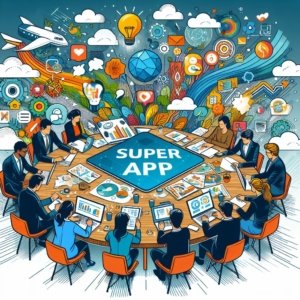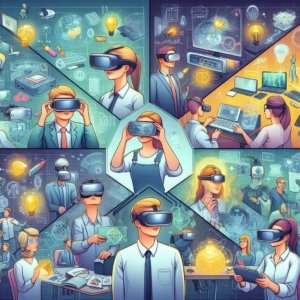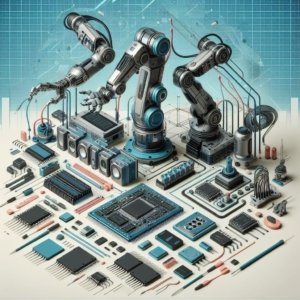This comprehensive guide provides a detailed overview of web development, covering its importance, historical background, and various types, including front-end, back-end, and full-stack development. It delves into the essential tools and frameworks utilized in each domain, emphasizing the role of front-end developers in creating captivating user interfaces and the responsibilities of back-end developers in managing server-side operations and databases. The guide highlights the dynamic nature of the industry, with a focus on rapidly evolving technologies, the competitive landscape, and the importance of continuous learning to stay ahead.
Furthermore, the guide explores the benefits of being a web developer, such as high demand, lucrative earning potential, opportunities for continuous learning, and flexibility in work arrangements. It provides reasons why individuals should consider pursuing a career in web development, ranging from the creative expression and problem-solving aspects of the profession to the potential for remote work. The future prospects of web development are discussed, emphasizing the industry’s growth and the need for professionals to adapt to emerging trends and technologies. The guide concludes with practical steps to start a career in web development, including traditional degree programs, online courses, personal projects, and networking, along with insights into salaries and job prospects at different career levels. Overall, it serves as a comprehensive resource for those aspiring to enter the dynamic and rewarding field of web development in 2024 and beyond.
What is Web Development?
Web development encompasses the creation, construction, and maintenance of websites and web applications. It involves a wide range of tasks and disciplines that contribute to the design, functionality, and user experience of online platforms. Web developers utilize various programming languages, frameworks, and tools to bring websites to life, ensuring that they are visually appealing, functional, and user-friendly.
There are three primary types of web development:
1. Front-end Development:
This type of development focuses on the user interface and involves creating the visual elements of a website or web application. Front-end developers utilize technologies such as HTML, CSS, and JavaScript to design and implement features that users directly interact with.
1.1 Essential Tools and Frameworks for Front-end Development
A. Text Editors and Integrated Development Environments (IDEs)
Text editors and IDEs are indispensable tools for front-end developers as they enable efficient code writing, editing, and management. Prominent choices in this domain include Atom, Visual Studio Code, and Sublime Text. These tools offer a range of features such as syntax highlighting, code completion, and built-in terminal access, which significantly enhance productivity and simplify the development process.
B. CSS Frameworks
CSS frameworks like Bootstrap, Foundation, and Bulma play a crucial role in expediting front-end development. They come equipped with pre-designed styles, components, and layout systems that facilitate rapid development. By providing a consistent and responsive design approach, these frameworks save developers valuable time and effort that would otherwise be spent on creating custom styles from scratch.
C. JavaScript Libraries and Frameworks
JavaScript libraries and frameworks, such as React, Angular, and Vue.js, are instrumental in streamlining the development of custom web applications. These tools offer reusable components, efficient state management, and optimized rendering, enabling developers to build interactive and scalable applications more effectively. By leveraging these libraries and frameworks, developers can enhance their productivity and deliver high-quality web applications.
2. Back-end Development:
Back-end development involves working on the server side of websites and applications. Back-end developers are responsible for managing data, server configurations, and implementing the logic that powers the functionality of a website. They utilize server-side programming languages such as Python, Ruby, PHP, or Java.
2.1 Key Elements of Back-end Development
A. Server-Side Programming Languages
Back-end developers utilize various server-side programming languages, such as Python, Ruby, PHP, or Java, to manage the business logic and server-side operations of websites or applications. These languages provide the necessary tools for developers to create dynamic content, handle data processing, and implement intricate functionalities.
B. Databases and Data Management
Back-end developers work closely with databases to efficiently store and retrieve data. They interact with database management systems like MySQL, PostgreSQL, or MongoDB to design database structures, create queries, and ensure the integrity of the data. Effective data management is crucial for applications that rely on user-generated content, e-commerce platforms, or data-driven functionalities.
C. APIs (Application Programming Interfaces)
APIs serve as the bridge for communication and data exchange between different systems or services. Back-end developers design and implement APIs to facilitate seamless integration between the front-end and back-end components of a web application or to enable third-party integrations. Well-designed APIs ensure secure and efficient data transmission, allowing developers to create robust and scalable applications.
D. Server Configuration and Deployment
Back-end developers are responsible for configuring servers, managing hosting environments, and deploying web applications. They ensure the smooth operation of servers, optimize performance, and handle security configurations. A comprehensive understanding of server infrastructure, cloud platforms, and deployment processes is essential for efficient back-end development.
E. Security and Authentication
Ensuring the security of web applications is a critical aspect of back-end development. Back-end developers implement authentication and authorization systems to safeguard user data, prevent unauthorized access, and handle sensitive information securely. They also adhere to industry best practices and employ security measures to mitigate potential vulnerabilities and protect against malicious attacks.
3. Full-stack Development:
Full-stack developers possess proficiency in both front-end and back-end development. They have a comprehensive understanding of the entire web development process and are capable of working on all aspects of a website or application.
Requirements for Web Development
Successful web developers possess a combination of technical expertise and innovative problem-solving capabilities. They must have a solid understanding of programming languages, frameworks, databases, and web development principles. Proficiency in HTML, CSS, JavaScript, and familiarity with various libraries and frameworks like React, Angular, or Node.js is crucial. Additionally, strong communication and collaboration skills are highly valuable for effective teamwork and client interaction.
Benefits of Being a Web Developer
1. High demand and job security
The field of web development offers a stable and secure career path due to the ever-increasing demand for professionals in this field. Companies actively seek web developers who can create engaging online experiences, making web development an in-demand skill set.
2. Lucrative earning potential
Web developers have the potential to earn a substantial income. As their skills and experience grow, they can command higher salaries or even establish their own web development agencies or consulting businesses, further increasing their earning potential.
3. Continuous learning and professional growth
Web development is a dynamic field that constantly evolves with emerging trends and technologies. This provides professionals with the opportunity for continuous learning and growth, ensuring that their skills remain relevant and in demand.
4. Flexibility and remote work opportunities
Web development often offers flexible work arrangements, including the possibility of remote work. This flexibility allows individuals to achieve a better work-life balance and tailor their working environment to their preferences, enhancing their overall job satisfaction.
5. Creative expression and problem-solving
Web development combines technical skills with creativity and problem-solving. Developers have the opportunity to bring their innovative ideas to life and solve complex challenges, making the profession intellectually stimulating and fulfilling. This aspect of web development allows individuals to express their creativity while finding practical solutions to real-world problems.
Why Choose a Career in Web Development?
There are several compelling reasons to consider a career in web development. Firstly, it provides a creative outlet for individuals who have a passion for technology and design. Web developers have the opportunity to showcase their creativity by designing visually appealing and user-friendly websites. This allows them to express their artistic abilities while also meeting the functional needs of clients and users.
What Does a Web Developer Do?
The role of a web developer encompasses the complete web development process, which involves the stages of planning, designing, implementing functionality, and maintaining websites. They work closely with clients, designers, and other individuals involved to produce visually captivating, user-friendly, and optimized websites. Their responsibilities encompass coding, testing, resolving issues, integrating third-party APIs, and ensuring the security and responsiveness of websites across various devices.
Are You a Good Fit for a Career as a Web Developer?
Determining if a career in web development is suitable for you requires careful consideration of your abilities, passions, and work approach. Those who derive satisfaction from resolving complex issues, possess a keen sense of aesthetics, exhibit meticulousness, and relish acquiring knowledge about emerging technologies often find themselves fitting well into the web development field. Additionally, effective communication and the ability to collaborate harmoniously with colleagues or clients are highly advantageous traits for ensuring productive teamwork.
Do You Have the Right Background to Become a Web Developer?
A web developer does not always require a specific educational background. Numerous accomplished individuals in this domain have taken unconventional routes, utilizing online resources, coding bootcamps, and self-guided learning. Nevertheless, to thrive in the industry, it is crucial to possess a strong understanding of programming principles, be well-versed in web technologies, and engage in continuous self-education.
Is It Worth Becoming a Web Developer in 2024?
Becoming a web developer in 2024 and beyond is undoubtedly a worthwhile pursuit. The field offers numerous opportunities for growth and success due to the increasing reliance on technology and the internet. Businesses and individuals will continue to demand web development expertise, ensuring job security and a rewarding career path. Additionally, the industry’s competitive nature necessitates staying updated with the latest trends and continuously expanding one’s skill set. By specializing in specific areas, staying current with industry standards, and demonstrating innovative solutions, web developers can secure desirable positions and thrive in this ever-evolving field. Moreover, the future of web development looks promising with the rapid evolution of technologies such as artificial intelligence, virtual reality, and mobile web development. By adapting to emerging technologies and trends, continuously learning, and upskilling, professionals can future-proof their careers and stay ahead in this dynamic industry.
The process of embarking on a career in web development entails several essential steps. These steps are as follows:
1) Traditional Degree Programs
Pursuing a computer science or software engineering degree from a reputable institution can provide a solid foundation in programming and computer science concepts.
2) Online courses and bootcamps
Online learning platforms and coding bootcamps offer immersive, hands-on training in web development. These programs are often designed to quickly equip individuals with the practical skills necessary for entry-level web development positions.
3) Learning Programming Languages
Start with foundational languages such as HTML, CSS, and JavaScript. As you progress, explore server-side languages like Python, PHP, or Ruby to enhance your back-end development skills.
4) Understanding HTML, CSS, and JavaScript:
These core languages are the building blocks of the web. Familiarize yourself with their syntax, features, and best practices to create engaging user interfaces and interactive web experiences.
5) Personal projects and portfolios
Develop your own websites or web applications to showcase your skills and create a strong portfolio. These projects can serve as tangible evidence of your abilities and passion for web development.
6) Freelancing and internships
Seek opportunities to gain real-world experience through freelancing or internships. Working on actual projects with clients or in a professional setting can provide valuable insights and help you develop collaboration and problem-solving skills.
7) Networking and building connections
Attend web development conferences, workshops, and meetups to network with industry experts. Participate in internet forums and open-source initiatives. Building relationships and networking can open doors to job opportunities and mentorship.
Salaries and Employment Opportunities
When contemplating a career in web development, it is essential to comprehend the potential salaries and job prospects associated with this field. This segment delves into the various factors that influence salaries within the web development industry and explores the employment opportunities available for professionals in this domain.
Average Salaries for Web Developers
Gaining an understanding of the average salaries for web developers at different stages of their careers provides valuable insights into their earning potential:
1) Entry-Level Salaries
Entry-level web developers typically earn a median salary ranging from $50,000 to $70,000 per annum. These positions often require foundational knowledge and skills, making them accessible to recent graduates or individuals transitioning into the field.
2) Mid-Level Salaries
Mid-level web developers, who have accumulated a few years of experience, can anticipate median salaries within the range of $70,000 to $90,000 per year. At this stage, professionals have solidified their skills and can undertake more complex projects and responsibilities.
3) Senior-Level Salaries
Senior web developers, possessing extensive experience and a proven track record of delivering high-quality projects, have the potential to earn salaries surpassing $100,000 per year. These professionals often assume leadership roles, mentor junior developers, and make significant contributions to the strategic direction of projects.
Factors Influencing Job Prospects
Several factors influence job prospects in the field of web development, and staying aware of these elements can help professionals navigate their careers effectively. Here are key factors that impact job prospects in web development:
1. Technological Advancements:
Keeping up with technological advancements is crucial. Employers seek developers who are adept at working with the latest tools, frameworks, and languages. Staying current with emerging technologies ensures relevance and competitiveness in the job market.
2. Industry Trends and Market Demand:
Adapting to industry trends and understanding market demand is essential. For example, skills related to mobile development, progressive web apps, and cloud computing may be particularly sought after in response to current market needs.
3. Skill Specialization:
Specializing in specific areas within web development, such as front-end frameworks, back-end technologies, or specialized domains like e-commerce or cybersecurity, can enhance job prospects. Employers often value the depth of expertise in addition to a broad skill set.
4. Experience and Portfolio:
A robust portfolio showcasing past projects and practical experience significantly influences job prospects. Real-world projects, whether personal or professional, demonstrate a developer’s capabilities and contribute to a strong professional profile.
5. Soft Skills and Communication:
Effective communication and collaboration skills are increasingly important in the workplace. Developers who can communicate technical concepts clearly, collaborate in team settings, and work well with clients are highly valued.
6. Continued Learning and Upskilling:
The web development field evolves rapidly. Job prospects are positively impacted by a commitment to continuous learning and upskilling. Professionals who invest time in staying informed about new technologies and trends remain competitive.
7. Educational Background:
While a formal degree is not always required, having a relevant educational background can positively influence job prospects. Some employers may prefer candidates with degrees in computer science, software engineering, or related fields.
8. Networking and Industry Involvement:
Building a professional network and actively participating in the web development community through events, conferences, and online forums can create valuable connections. Networking can lead to job opportunities, collaborations, and mentorship.
9. Geographic Location:
Job prospects can vary based on geographic location and local demand for web development skills. Some areas may have a higher concentration of tech companies, startups, or digital agencies, offering more opportunities for developers.
10. Work Experience and Reputation:
Building a positive reputation within the industry through successful project deliveries, positive client interactions, and contributions to open-source projects can enhance job prospects. Employers often value a developer’s work history and the impact they’ve had in previous roles.
Challenges in Web Development
Web development, while a rewarding field, comes with its set of challenges. Developers need to navigate these challenges to ensure the successful creation and maintenance of websites and applications. Here are some key challenges in web development:
1. Rapidly Evolving Technology:
The fast-paced evolution of web technologies poses a challenge for developers to stay updated with the latest tools, frameworks, and languages. Adapting to new technologies is essential for remaining competitive and delivering cutting-edge solutions.
2. Cross-Browser Compatibility:
Ensuring that websites and applications work seamlessly across different web browsers (such as Chrome, Firefox, Safari, and Edge) can be challenging. Each browser has its rendering engine and quirks, requiring thorough testing and adjustments to achieve consistency.
3. Responsive Design and Mobile Optimization:
The increasing use of mobile devices necessitates creating responsive and mobile-friendly designs. Developers must ensure that websites adapt to various screen sizes and resolutions, providing an optimal user experience across devices.
4. Security Vulnerabilities:
Web developers face the constant challenge of addressing security vulnerabilities to protect user data and prevent unauthorized access. Mitigating threats such as cross-site scripting (XSS) and SQL injection requires implementing robust security measures and staying informed about the latest security trends.
5. Performance Optimization:
Optimizing website performance is crucial for providing a smooth user experience. Developers need to address factors such as page load times, efficient code, and optimized images to ensure fast and responsive websites.
6. Accessibility:
Developers must consider accessibility guidelines to ensure that websites and applications are usable by individuals with disabilities. Adhering to standards like WCAG (Web Content Accessibility Guidelines) involves considerations for design, keyboard navigation, screen reader compatibility, and semantic HTML structure.
7. Collaboration and Project Management:
Web development often involves collaboration with designers, content creators, and stakeholders. Effective communication, collaboration, and project management skills are essential for ensuring smooth workflows, meeting project deadlines, and delivering high-quality solutions.
8. Evolving Web Standards and Browser Support:
Web standards and browser support continually evolve. Developers must stay updated with new standards, features, and browser compatibility to ensure that websites remain compatible with modern browsers and provide consistent user experiences.
Despite these challenges, web development offers opportunities for creative expression, problem-solving, and continuous learning. Successful developers navigate these obstacles by staying informed, embracing best practices, and leveraging their skills to create robust and innovative web solutions.

 Artificial Intelligence (AI) stands as a dynamic field within computer science, central to technological advancements and permeating various industries. It involves creating intelligent systems capable of human-like tasks, leveraging machine learning, natural language processing, and computer vision. Machine learning algorithms, driven by extensive datasets and advanced neural networks, play a pivotal role in enhancing decision-making processes and automating routine tasks. Noteworthy organizations, including Google, Microsoft, and
Artificial Intelligence (AI) stands as a dynamic field within computer science, central to technological advancements and permeating various industries. It involves creating intelligent systems capable of human-like tasks, leveraging machine learning, natural language processing, and computer vision. Machine learning algorithms, driven by extensive datasets and advanced neural networks, play a pivotal role in enhancing decision-making processes and automating routine tasks. Noteworthy organizations, including Google, Microsoft, and  Sustainable technology, a transformative approach to innovation, prioritizes environmental responsibility and resource efficiency to address global challenges. From renewable energy sources to circular design principles, sustainable technology spans various domains, including energy efficiency, circular economy practices, and eco-friendly materials. It plays a pivotal role in promoting clean energy, optimizing resource use in agriculture, and fostering green transportation. The circular economy model reduces waste through recycling and sustainable design principles. Beyond technological advancements, sustainable technology influences corporate practices, driving commitments to renewable energy and corporate sustainability. As a holistic and forward-thinking approach, sustainable technology emerges as a key player in creating a greener and more resilient future.
Sustainable technology, a transformative approach to innovation, prioritizes environmental responsibility and resource efficiency to address global challenges. From renewable energy sources to circular design principles, sustainable technology spans various domains, including energy efficiency, circular economy practices, and eco-friendly materials. It plays a pivotal role in promoting clean energy, optimizing resource use in agriculture, and fostering green transportation. The circular economy model reduces waste through recycling and sustainable design principles. Beyond technological advancements, sustainable technology influences corporate practices, driving commitments to renewable energy and corporate sustainability. As a holistic and forward-thinking approach, sustainable technology emerges as a key player in creating a greener and more resilient future. Web 3.0 represents a paradigm shift toward a decentralized internet framework, prioritizing enhanced user engagement and openness. At the core of this evolution decentralized applications, blockchain technology, and artificial intelligence, which will play a key role in creating a more open, secure, and intelligent web.
Web 3.0 represents a paradigm shift toward a decentralized internet framework, prioritizing enhanced user engagement and openness. At the core of this evolution decentralized applications, blockchain technology, and artificial intelligence, which will play a key role in creating a more open, secure, and intelligent web. Quantum computing has transitioned from being a distant promise to a tangible reality that is revolutionizing data processing and encryption. Its ability to solve intricate problems at an exponential pace compared to classical computers has opened up new horizons. Renowned industry giants like
Quantum computing has transitioned from being a distant promise to a tangible reality that is revolutionizing data processing and encryption. Its ability to solve intricate problems at an exponential pace compared to classical computers has opened up new horizons. Renowned industry giants like  The metaverse, a convergence of augmented reality (AR) and virtual reality (VR), is pivotal for businesses exploring immersive digital experiences.
The metaverse, a convergence of augmented reality (AR) and virtual reality (VR), is pivotal for businesses exploring immersive digital experiences. Super apps have revolutionized the way users interact with digital services by offering a comprehensive range of services within a single ecosystem. These apps are constantly evolving, incorporating more features and expanding their reach, thereby reshaping the digital landscape. By providing users with unmatched convenience and accessibility across various services, super apps have become a game-changer in the digital world. The success of these apps can be attributed not only to their technological advancements but also to their ability to adapt to the changing needs of users in an interconnected digital era.
Super apps have revolutionized the way users interact with digital services by offering a comprehensive range of services within a single ecosystem. These apps are constantly evolving, incorporating more features and expanding their reach, thereby reshaping the digital landscape. By providing users with unmatched convenience and accessibility across various services, super apps have become a game-changer in the digital world. The success of these apps can be attributed not only to their technological advancements but also to their ability to adapt to the changing needs of users in an interconnected digital era. The importance of a robust digital immune system cannot be overstated as cyber threats continue to rise. AI-driven cybersecurity solutions have emerged as a key player in this field, with the ability to autonomously identify and address threats. Notable companies such as Darktrace, Palo Alto Networks, and CrowdStrike have recognized the significance of digital immune system technologies and have invested in them. It is projected that the global cybersecurity market will reach a staggering $352.25 billion by 2026.
The importance of a robust digital immune system cannot be overstated as cyber threats continue to rise. AI-driven cybersecurity solutions have emerged as a key player in this field, with the ability to autonomously identify and address threats. Notable companies such as Darktrace, Palo Alto Networks, and CrowdStrike have recognized the significance of digital immune system technologies and have invested in them. It is projected that the global cybersecurity market will reach a staggering $352.25 billion by 2026. AI TRiSM (Trustworthy, Responsible, and Ethical AI; Transparent, Secure, and Mindful AI) represents the ethical evolution of artificial intelligence. As AI embeds further in business operations, ensuring trust, responsibility, transparency, and security becomes paramount.
AI TRiSM (Trustworthy, Responsible, and Ethical AI; Transparent, Secure, and Mindful AI) represents the ethical evolution of artificial intelligence. As AI embeds further in business operations, ensuring trust, responsibility, transparency, and security becomes paramount. Edge computing is a revolutionary approach that enables data processing to occur near its source, resulting in minimized latency. This paradigm shift not only enhances real-time processing capabilities but also improves efficiency and security.
Edge computing is a revolutionary approach that enables data processing to occur near its source, resulting in minimized latency. This paradigm shift not only enhances real-time processing capabilities but also improves efficiency and security. AR and VR technologies are revolutionizing the manner in which we engage with the digital and physical realms. These transformative technologies surpass conventional screens, providing captivating experiences that seamlessly merge the virtual and real worlds. With their distinct capabilities, AR and VR have found utility in various sectors, including entertainment, gaming, healthcare, education, and enterprise.
AR and VR technologies are revolutionizing the manner in which we engage with the digital and physical realms. These transformative technologies surpass conventional screens, providing captivating experiences that seamlessly merge the virtual and real worlds. With their distinct capabilities, AR and VR have found utility in various sectors, including entertainment, gaming, healthcare, education, and enterprise. Robotics and automation represent a transformative field that integrates intelligent machines and technologies to perform tasks traditionally carried out by humans. Robotics involves the design, creation, and operation of robots, while automation refers to the use of technology to control and execute processes without human intervention.
Robotics and automation represent a transformative field that integrates intelligent machines and technologies to perform tasks traditionally carried out by humans. Robotics involves the design, creation, and operation of robots, while automation refers to the use of technology to control and execute processes without human intervention. Biotechnology harnesses the power of living organisms to drive innovation, making significant impacts in the fields of medicine, agriculture, and industry. In the realm of medicine, it plays a crucial role in the development of personalized therapies and cutting-edge gene editing technologies such as CRISPR-Cas9. Agricultural biotechnology, on the other hand, enhances crop traits through genetic modification, while industrial and environmental applications involve biofuel production and bioremediation.
Biotechnology harnesses the power of living organisms to drive innovation, making significant impacts in the fields of medicine, agriculture, and industry. In the realm of medicine, it plays a crucial role in the development of personalized therapies and cutting-edge gene editing technologies such as CRISPR-Cas9. Agricultural biotechnology, on the other hand, enhances crop traits through genetic modification, while industrial and environmental applications involve biofuel production and bioremediation. The importance of zero-trust architecture, secure access service edge (SASE), and quantum-safe cryptography cannot be underestimated. To effectively safeguard against cyber threats, organizations must adopt a comprehensive defense strategy that encompasses various elements. This includes fostering individual awareness, implementing the Zero Trust security model, implementing robust endpoint security measures, and integrating cloud security protocols.
The importance of zero-trust architecture, secure access service edge (SASE), and quantum-safe cryptography cannot be underestimated. To effectively safeguard against cyber threats, organizations must adopt a comprehensive defense strategy that encompasses various elements. This includes fostering individual awareness, implementing the Zero Trust security model, implementing robust endpoint security measures, and integrating cloud security protocols. Smart Agriculture, also referred to as precision agriculture, integrates advanced technologies into conventional farming methods to optimize efficiency, improve productivity, and promote sustainability. By utilizing Internet of Things (IoT) devices, precision farming techniques, remote sensing, data analytics, and artificial intelligence, farmers are empowered to make well-informed, data-driven decisions regarding crop management, resource allocation, and environmental impact.
Smart Agriculture, also referred to as precision agriculture, integrates advanced technologies into conventional farming methods to optimize efficiency, improve productivity, and promote sustainability. By utilizing Internet of Things (IoT) devices, precision farming techniques, remote sensing, data analytics, and artificial intelligence, farmers are empowered to make well-informed, data-driven decisions regarding crop management, resource allocation, and environmental impact.